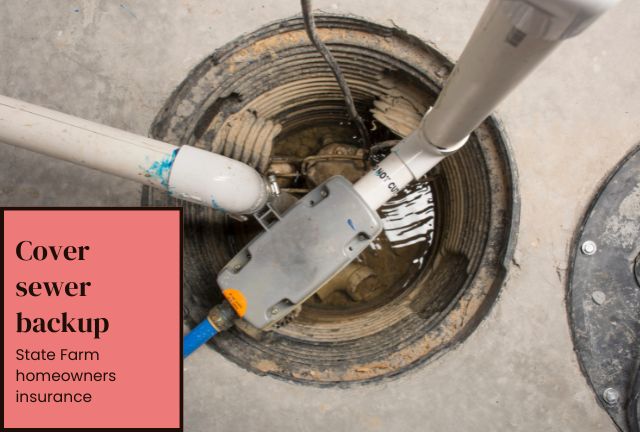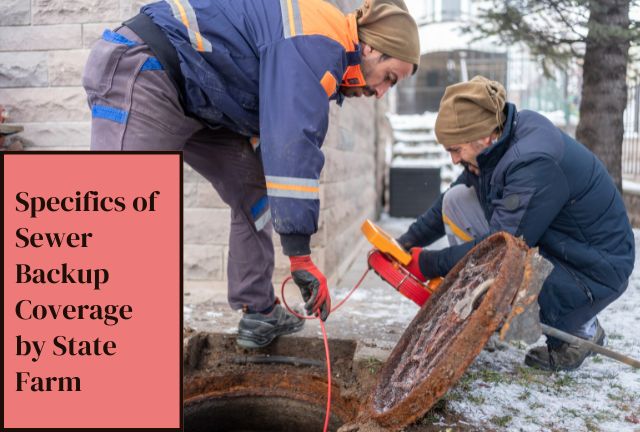Does state farm homeowners insurance cover sewer backup? Understanding whether State Farm homeowners insurance covers sewer backup is crucial for homeowners in the United States, especially given the potential costs and damages associated with this issue. Sewer backup incidents can lead to significant property damage and require costly repairs, making comprehensive insurance coverage essential. This article explores State Farm’s approach to sewer backup coverage, providing detailed insights into what homeowners can expect from their policies.

State Farm Home Insurance for Plumbing Issues
1, Understanding Sewer Backup Coverage
Sewer backup refers to the situation where sewage or wastewater backs up into a home through drains or plumbing fixtures. According to the Insurance Information Institute, sewer backups are not typically covered under standard homeowners insurance policies. This exclusion can leave homeowners vulnerable to expensive cleanup and restoration costs in the event of a sewer backup.
In the United States, sewer backups are a common problem, affecting many homes each year. The costs associated with cleaning up after a sewer backup can range from several thousand to tens of thousands of dollars, depending on the extent of the damage and the cleanup required. This underscores the importance of having adequate insurance coverage that specifically addresses sewer backup incidents. Does state farm homeowners insurance cover sewer backup is an issue that many people are concerned about.
2, Overview of State Farm Homeowners Insurance
State Farm is one of the largest and most well-known insurance providers in the United States, offering a range of homeowners insurance policies. State Farm’s standard homeowners insurance typically provides coverage for common perils such as fire, theft, and certain types of water damage. So, does state farm homeowners insurance cover sewer backup?
However, when it comes to sewer backup coverage, State Farm often offers this as an optional endorsement or rider to their standard policies. This means that homeowners may have the option to add sewer backup coverage to their policy for an additional premium. It’s important for homeowners to review their specific State Farm policy to determine whether sewer backup coverage is included or if it can be added as an endorsement.
State Farm’s approach to sewer backup coverage may vary depending on the state and individual policy details. Therefore, homeowners should consult with a State Farm agent to understand their coverage options and ensure they have adequate protection against sewer backup incidents.
3, Specifics of Sewer Backup Coverage by State Farm

State Farm Homeowners Policy Water Backup Coverage
State Farm offers sewer backup coverage as an optional endorsement to their homeowners insurance policies. Here are key specifics regarding sewer backup coverage by State Farm:
- Optional Endorsement: Sewer backup coverage is not automatically included in standard State Farm homeowners insurance policies. Instead, homeowners can choose to add this coverage to their policy for an additional premium.
- Coverage Details: State Farm’s sewer backup endorsement typically covers damages caused by sewer or drain backups, including cleanup and restoration costs associated with the incident. This can include damage to floors, walls, personal belongings, and other affected areas of the home.
- Coverage Limits and Deductibles: Like other insurance coverages, State Farm’s sewer backup coverage may have specific limits and deductibles. Homeowners should review their policy details to understand the maximum coverage amount and any out-of-pocket costs in the event of a claim.
- Comparative Analysis: When comparing sewer backup coverage offered by State Farm with other insurers, it’s important to consider the scope of coverage, cost of endorsement, and reputation for claims handling. State Farm’s coverage options and customer service may differ from other insurance providers, making it essential for homeowners to evaluate their options based on individual needs.
4, Factors Affecting Coverage and Claims
Several factors can influence sewer backup coverage and claims under State Farm homeowners insurance:
- Policy Endorsements: The specific coverage for sewer backup will depend on whether homeowners have added the sewer backup endorsement to their State Farm policy. Without this endorsement, sewer backup incidents may not be covered.
- Policy Limits and Deductibles: The coverage limits and deductibles chosen by homeowners can impact the extent of coverage available for sewer backup incidents. Higher coverage limits may result in higher premiums but provide more financial protection in case of a sewer backup claim.
- Location: The geographic location of the home can affect insurance coverage and rates. Homes in areas prone to sewer system issues or high water tables may have different coverage needs compared to homes in low-risk areas.
- Preventative Measures: Some insurance policies may require homeowners to take preventative measures, such as installing backwater valves or maintaining sewer lines, to qualify for sewer backup coverage. Compliance with these requirements can affect coverage eligibility and claims processing.
- Claims History: A homeowner’s claims history, including any previous sewer backup claims, may impact future coverage options and premiums.
5, Comparing State Farm with Other Insurance Providers
When considering sewer backup coverage, it’s important to compare State Farm with other insurance providers:
- Coverage Options: Compare the availability and scope of sewer backup coverage offered by State Farm with other insurers. Some insurers may include sewer backup coverage as a standard feature, while others offer it as an optional endorsement.
- Premium Costs: Evaluate the cost of adding sewer backup coverage to your homeowners insurance policy with different insurers. Compare premium rates, deductibles, and coverage limits to determine which option provides the best value for your needs.
- Claims Process: Research the claims handling reputation of different insurers, including State Farm. Look for customer reviews and feedback regarding the ease and efficiency of filing and processing sewer backup claims.
- Customer Service: Consider the level of customer service provided by insurers. State Farm is known for its personalized service, but it’s important to assess how other insurers handle customer inquiries and claims related to sewer backup incidents.
Comparing these factors can help homeowners make an informed decision when choosing an insurance provider for sewer backup coverage.
6, Importance of Sewer Backup Endorsements
Adding a sewer backup endorsement to your homeowners insurance policy can offer several benefits:
Enhanced Protection: Sewer backup endorsements provide additional coverage for damages caused by sewer or drain backups, which are typically excluded from standard policies.
Financial Security: Sewer backup incidents can result in costly repairs and cleanup. Having sewer backup coverage can provide financial security and peace of mind knowing that you’re protected against these unexpected expenses.
Comprehensive Coverage: By adding a sewer backup endorsement, homeowners can ensure their insurance policy covers a wider range of perils, including sewer-related issues that are common but often overlooked.
Tailored Coverage: Sewer backup endorsements can be customized to meet individual needs and preferences. Homeowners can adjust coverage limits and deductibles based on their budget and risk tolerance.
Ultimately, sewer backup endorsements offer a proactive approach to protecting your home and belongings from potential sewer-related damages.
7, Frequently Asked Questions (FAQs)
Common questions about sewer backup coverage under State Farm homeowners insurance include:
7.1, Does State Farm automatically cover sewer backup?
Sewer backup coverage is typically not included in standard State Farm policies and must be added as an endorsement.
How much does sewer backup coverage cost with State Farm?
The cost of sewer backup coverage varies depending on factors such as location, coverage limits, and deductible. Homeowners should consult with a State Farm agent for specific pricing details.
7.2, What does sewer backup coverage under State Farm include?
Sewer backup coverage typically includes damages caused by sewer or drain backups, including cleanup and restoration costs.
7.3, How do I add sewer backup coverage to my State Farm policy?
Homeowners can contact their State Farm agent to inquire about adding sewer backup coverage to their existing homeowners insurance policy.
8, How to Obtain Sewer Backup Coverage with State Farm
Adding sewer backup coverage to your State Farm homeowners insurance policy is a straightforward process:
- Contact Your State Farm Agent: Reach out to your local State Farm agent to discuss adding sewer backup coverage to your policy.
- Review Coverage Options: Your agent will provide information about sewer backup endorsements, including coverage limits, deductibles, and premium costs.
- Customize Your Policy: Work with your agent to customize your homeowners insurance policy to include sewer backup coverage based on your specific needs and budget.
- Finalize and Update: Once you’ve selected sewer backup coverage, your agent will assist in finalizing the policy update and providing you with updated policy documents.
Does state farm homeowners insurance cover sewer backup? By following these steps, homeowners can enhance their insurance coverage with sewer backup protection from State Farm, ensuring comprehensive protection against sewer-related damages.